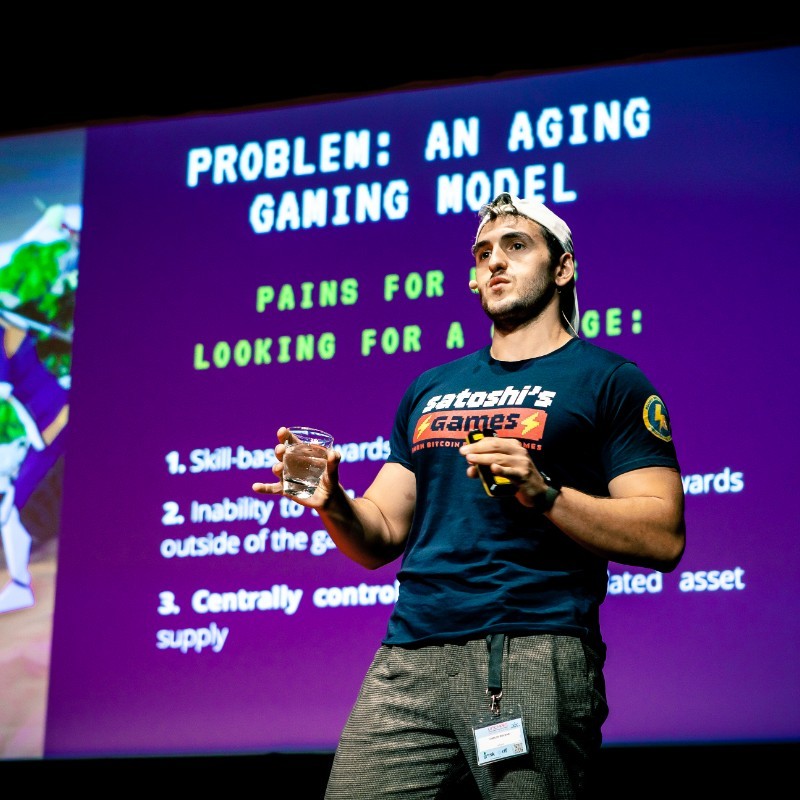Welcome to the July edition of BlockchainGamer.biz’s regular Mavens group. If you’d also like to join the discussion, please contact [email protected]
Of all the factors to take into account when choosing on which blockchain to deploy a game, which is the most important one and why?
Robbie Ferguson – Co-founder and President, Immutable

At Immutable, we believe the most important consideration is the blockchain’s focus on gaming. This includes assessing how aligned the blockchain is to the success of your game. We consider whether their technology is built with game economies in mind, rather than primarily for DeFi or other use cases. It’s crucial that their team, including Business Development, Partner Success, and Support, deeply understands the challenges game developers face daily. This understanding should be reflected in their technology stack, services, and support. We also evaluate whether the network’s users are primarily gamers or crypto mercenaries looking for the next arbitrage or narrative opportunity. Finally, we assess if their monetization incentives align with those of a game studio.
Working with ecosystems that deeply understand the problems game developers face will help teams navigate the many pitfalls of building in web3. This, in turn, allows developers to focus on their primary objective: shipping fun and engaging experiences to players.
Kevin Rose – CMO, Dacoco

There are two parts to this. The first part: all blockchains present the same “Trilemma” famously coined by Vitalik. In a blockchain you want security, scalability, and decentralization. Gamers need immediate feedback in a game so we need to focus on scalability above all else.
But blockhains have a fourth value, network effect. Because blockchains are closed systems often with steep onboarding asks, game developers also need to focus on where the largest potential market of players is. Finding that sweet spot between speed and player onboarding is the key.
The second part: in the future, players won’t care what blockchain you deploy on. It’ll be that players want to trade in-game items, not trade them on XYZ blockchain.
David Bolger – Senior partnerships manager, Offchain Labs

Economic activity, gamer UX and support are the three areas that game studios mainly optimise for when choosing which chain to deploy on.
Economic activity: With tokens as the lifeblood of many web3 game economies, having a liquid network is crucial.
Gamer UX: Transaction speed is crucial to retaining users who are used to minimal loading times. Beyond speed, support from centralized exchanges, fiat on-ramps, marketplaces and high quality gaming wallets is pertinent. With the explosive growth in new chains, the infrastructure providers have not maintained pace with the adoption and therefore some new chains lack key infra.
Support: The support from a chain can include co-marketing, grants, investment, technical support and more. Word of mouth around which chains support teams over a long time horizon vs those that focus on the upfront announcement is a strong driver of teams decision making.
Overall, Arbitrum has been optimizing for these areas in particular. The Foundation and DAO is doubling down on this with the 200 million Arb gaming catalyst program that recently passed voting.
Christina Macedo – CEO, READYgg

Scalability tops the list because it’s all about supporting growth without losing a beat. And scalability can impact not just the technical performance, but also the overall user experience.
Scalability also ties directly into security and decentralization. It’s important for a blockchain to be scalable while having the right security measures in place to protect against fraud and hacks. At the same time, we need to maintain a level of decentralization so we can efficiently process transactions to support complex game mechanics and a high number of concurrent users – while upholding trust and transparency.
Our aim is to strike the right balance for a scalable, secure, and user-friendly gaming environment that fosters innovation and maintains the integrity of the gaming experience.
Sicco Naets – Head of ecosystem dev, Moonbeam Foundation

If all you’re getting from a blockchain is a grant, then you’re getting poor service. Blockchains can help with several other important areas that are undervalued, including networking and introductions to VCs. They can also assist at a technical level and with co-marketing. Not all chains are equal in their responsiveness and willingness to support.
Beyond that, priority input into the product roadmap can be very valuable. You want a chain that prioritizes your tech needs, as that can save both headaches and money.
Lastly, blockchains can help with user acquisition. Chains can create events (like Moonbeam’s Lunar Gaming Festival) and tournaments to directly stimulate game interest and user adoption.
Robby Yung – CEO, Animoca Brands

I think the most important factor when choosing a blockchain to deploy a game is the community. While it is true that your game may attract players from elsewhere (other blockchains, web2, etc.), you need to engage a core base of supporters native to the locale you’re building. This is why it’s important to start engaging with the community early and understanding what they like, what other similar applications and content exist in that community, and what you’re planning to add to their community experience.
A perfect example of this is the game Pixels, which really accelerated its growth after moving to Ronin, where they found a core base of players who were familiar with farming sim games that were relatively easier to onboard because they were a good fit.
Tony Pearce – Co-founder, Reality+

At Reality+ we have a partnership with the Hedera network and HBAR Foundation to mint, sell and trade NFTs for our new Doctor Who: Worlds Apart mobile and PC trading card game. When choosing a blockchain to deploy a game, for us, it came down to three important factors – high transaction speeds, low fees and proven sustainability.
Doctor Who: Worlds Apart is aimed at mass market CCG players and has the potential to have millions of players and concurrent users. It was essential that we had a blockchain that could handle high transaction speeds and scalability with low transaction fees. Sustainability and energy consumption was an important factor especially when working with the BBC. We needed a blockchain that was one of the most sustainable public distributed ledgers.For Doctor Who: Worlds Apart, we have already minted 1.5 million collectible NFTs, which are being sold and traded by early adopters of the PC game, a testament to the high throughput, fast, and cost-efficient credentials of the network.
Anthony Palma – Gaming partnership lead, Mysten Labs

There isn’t one specific factor, but rather a combination of three critical requirements – performance, functionality, and support. From a performance standpoint, the blockchain must prioritize scalability, speed, and low costs – all three, not just a combination of the group.
Object models and robust tooling have to be part of the functionality of the blockchain, while the support system should encompass engineering, marketing, GTM, and funding if need be. Without all three, you’ll have to fight unnecessary battles to build, deploy, and launch the game you want without significant workarounds.
Quinn Kwon – Head of web3 strategy, Delabs

Our focus is on user convenience and quality, meaning our games have a manageable number of on-chain elements. However, the speed and low cost of transactions remain essential factors.
Additionally, considering an L2’s user base’s size and activity level is crucial since a large, active community can drive greater engagement and faster growth for the game. A high concentration of quality games can attract more users. Conversely, fewer competitors might allow our game to dominate the ecosystem, offering a strategic advantage.
Furthermore, ensuring that the chosen L2 solution aligns with our ecosystem positioning strategy is vital. It involves deciding whether to position our game as a leading title in a less crowded ecosystem or to compete in a dynamic, competitive environment based on our strategic objectives.
Marketing support is another critical consideration. Platforms that actively promote gaming content through their main channels, rather than segregating it, can offer greater exposure due to their larger follower base and higher visibility.
Russell Bennett – CEO, Metacade

The common belief in the gaming space is that the next billion users will come through a game, but I believe it’s the blockchain that will facilitate this growth. We recently chose Base for Metacade, with the decision driven by our business goals and desired outcomes. We positioned ourselves on Base to ensure we are front of mind for new users, helping them learn about the wider gamefi space.
In my view, games should adopt a similar strategic approach when choosing their blockchain. It’s crucial to find a chain with a significant number of on-chain users to benefit from cross-pollination. There are popular ecosystems gaining traction with many games deploying on them, attracting more gamers. However, this is a short-term view. Projects should focus on chains offering a frictionless, gas-free experience and a public commitment to onboarding users.
The key question for any project is whether the chosen chain aligns with their business goals.
Alexander Goldybin – Founder and chairman, iLogos

When you’re deciding which blockchain to use for your game, think about scalability first. You need a platform that can handle a lot of action without slowing down or getting too expensive. For example, Solana and Binance Smart Chain are great because they can manage lots of transactions quickly. This means your game will stay fun and responsive, just as players expect.
But don’t forget about the user base. Choosing a blockchain like Polygon, which already has a large, active community, means there’s a ready-made audience eager to try your game. This can give your game a head start in popularity.
In the end, the best choice is a blockchain that balances both scalability and a strong user base.
Carlos Roldan – CEO, Elixir Games

Processing speeds and transactions per second (TPS) are incredibly important for choosing a network. Networks designed to handle massive amounts of data quickly and that can readily support high throughput games will be crucial to the overall success of any title.
Partnering with networks that are easy to learn how to use for newcomers to web3 is another important factor. This is the main problem that L2s and L3s face, despite solving the data processing issue, as they complicate the onboarding experience. No gamer is going to sign up for 3 hours of homework to try a new game they don’t know they like yet.
This emphasis on onboarding extends to the game development as well, with all-in-one wallet solutions for handling player assets seeming to be the easiest answer available right now. At Elixir Games, we are working on integrating all of this into an all-in-one gaming platform so the technicalities of connecting blockchains are handled by us, not the gamer.
Sam Barberie – Head of strategy and partnerships, Horizon Blockchain Games

In the Maslow’s Hierarchy of Web3 Game Developer Needs, many developers get lost thinking about things that don’t matter in the long term, particularly in an increasingly commoditized chain landscape. Typically, games are looking for: 1) Money; 2) Access to “gamers.”
Here’s the real deal with each of those needs:
1) If a chain investment is the make or break of your game, you’re likely already DOA. Yes, capital is important for game development. And I firmly believe that great games can come from anywhere, even solo devs for whom some extra cash could be the difference between making the next viral hit and sticking to your day job.
At the same time, the era of free absurd money is largely over, and there needs to be recognition from devs that chains will not earn back the grant money they give you; you simply won’t use enough gas to make it happen. Traditional games don’t get paid by Steam, or Unreal, or Unity. It’s time for this concept of money-above-all to end, because it is not bringing great games to market, and the money well is drying up.
2) Chains do not have access to “gamers.” Some chains have access to bots, but there are simply not enough people who will actually play your game currently onboarded to web3.
Yes, co-marketing support from a chain is helpful. Yes, web3-natives are an important part of your game’s economy. But a one-time tweet from a chain’s main account is not going to bring you your 1,000 true fans.
Beyond this, most chains don’t have mechanisms for reaching users outside of social accounts, so what they’re doing isn’t any more special than what any other KOL/streamer/influencer can do, except those people reach actual players.
Moreso, the blockchain is an open database, as a dev you can throw a token “ad” into anyone’s wallet, on any chain, at any time. Entities that aren’t chains like guilds can also help you reach people, and that’s agnostic of the chain.
As a developer, however, be mindful of what you ask is, and understand the specifics of how the chain will help you reach the audience that will benefit your game in the long term.
All other things being equal, the team behind a chain – and the degree to which they understand game development, the challenges of web3 game development, and have a network of casual and formal relationships to help support your go to market – is going to make the difference. That’s where the arrival of new gaming-specific L2s and L3s is exciting, because it means more chains with more people dedicated to you with domain expertise.
Who has the knowledge to help you get approved for the App Store? Who understands how to design a game for different player profiles? Who can help you figure out the issue you’re having with multiplayer matchmaking? This is where chains are really starting to differentiate, either through their own staff or by leaning on an ecosystem of experts that will bring the next generation of great games to market.
Mike Levine – Founder, Mystic Moose

One of the most dynamic elements of working in blockchain is that it’s constantly evolving and improving. At Planet Mojo, based on our experiences in multi-platform game development, we’ve always believed in a multi-chain future.
Regardless, it is always important to choose long term partners that align with your long term vision and values as well as have a track record of being able to execute at a high level in a timely manner.
Sometimes, you will find a single, perfect partner but oftentimes there can be a divergence and you are a 70-80% match. Now you can choose from several partners that together may form that perfect 100% for your needs. We foresaw this evolution and built a robust back-end tech stack named “Sumatra” to support a multi-chain future where players can hold assets on diverse chains but still play games together.

